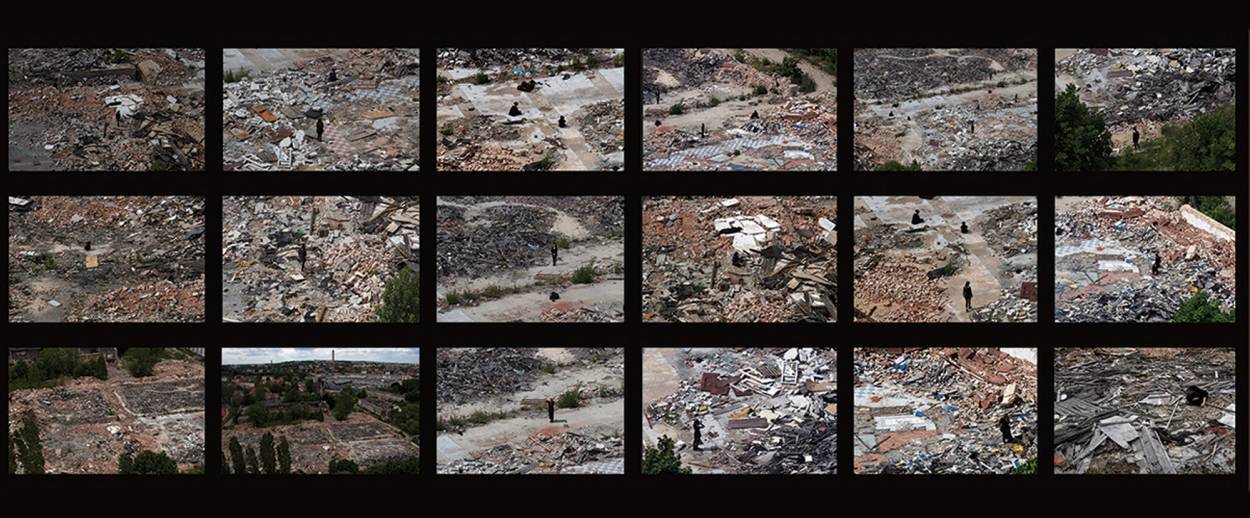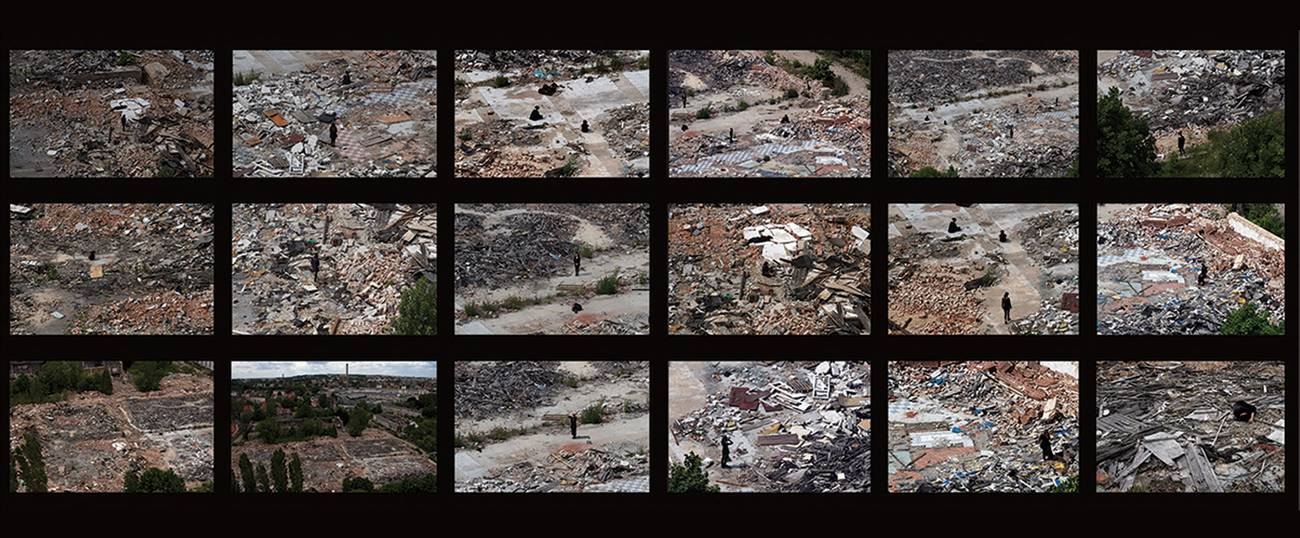The Lamentation Project
Polish artist Monika Weiss’ ‘post-memory’ project in Zielona Góra asks who owns past Jewish suffering




In January, I visited Polish artist Monika Weiss in her New York studio, and we talked about the lamentation project and a few others she’s worked on recently. Weiss, who is in her early fifties, dresses in black and has a lovely pale, oval face. Her dark hair is wrapped tightly behind her ears so it almost looks as though she wears a Commedia dell’arte skullcap. Not a sad clown but a transdisciplinary artist, Weiss has built a reputation for installations that include drawings of her own body, photographs, rhythmic movement, video, synthesized music (combining ambient sounds, the vocalization of a male soprano, and fragments of Baroque music, which she alters, chops up, and sometimes plays backwards), as well as simple objects or props such as books, scarves, and bandages.
A decade ago, Weiss drew attention for performances in which she videotaped her naked body immersed for hours in a large chalice of water or in which she slithered, rolled, and slowly dragged herself (followed by some students) along gigantic sheets of white canvas, leaving behind charcoal and crayon marks or traces of ink and water. Using her tortured (or enraptured) body she explored birth, death, and private and public space. Art critic Benjamin Genocchio, who praised the performances for their courage and creativity, said, “If you try to think rationally about these artworks, you will give yourself a headache.”
More recently she’s worked in a Grotowski-like fashion, training young women to participate in classical lamentations, which they perform while she records them. Like many artists (Alfredo Jaar and Maria Fernanda were featured in Pérez Art Museum Miami’s [PAMM] new series of Global Positioning Systems, drawing attention to tragedy in Brazil’s goldmines and Colombia’s civil war, respectively), she’s interested in projects of commemoration and memory, raising questions about how an artist—not a witness or a survivor—should react to the traumas of history and what constitutes post-memory. In Poland, where disclosure of the atrocities at Jedwabne (farther east) has created an ongoing crisis in Polish-Jewish relations, there’s excruciating sensitivity about memory of the war years. To whom does memory belong? Who has the right to respond to it? If people don’t have the ability or desire to respond, then what?
This is the beginning of the questionnaire Weiss distributed in the city Zielona Góra as part of her 2012 project at the site of a former concentration camp in the center of the city:
Cities around the world contain layers of memory, which are sometimes visible through their architecture. In some cases memory is hidden as well as actively removed from citizens’ consciousness. In your own words, tell us what ways you think cities should consider public memory?
Not surprisingly, there were very few responses. During the Nazi era, Zielona Góra (at that time, Grunberg) was the site of a slave labor camp and then a concentration camp where about a thousand young women, mostly Jewish teenagers from neighboring towns, worked at the Deutsche Wollenwaren textile factory. They worked as seamstresses, weavers, and wool-spinners, and they operated textile machines that produced materials for the German military. The young women worked under brutal conditions. Some were transported to Auschwitz before the evacuation of the camp in January 1945. About 30 percent died during the inconceivably harsh death marches. After the war, during the early Communist period, most of the German population in the region fled or was expelled, and new families from farther east moved to Zielona Góra. The textile factory was renamed Polska Welna, and when Weiss visited the area there was no public memory of the German concentration camp except for a small plaque placed very low on the wall—as Weiss said, “about at the level of the bushes or a small dog”—by the abandoned and flattened area of the former barracks. In typical Soviet-era fashion, it read, “To commemorate Polish women from the outside camp KZ Groß-Rosen, the ones who were murdered by the Nazis in the years 1944-1945. The staff of Polska Wełna, Zielona Góra.” No mention that the women had been Jews who were living inside what was then Germany and, for the most part, spoke German.
‘If you try to think rationally about these artworks, you will give yourself a headache.’
Strangely, although the city was redeveloped, the barracks area of the camp itself was left alone. Perhaps urban planners once thought of it as a sacred location, but to most of the people who had been relocated to the city after the war, it looked like a spot someone had forgotten to clean up. Over the years, and little by little, scavengers picked away at it, turning the old concentration-camp barracks first into broken walls of debris, then into piles of rubble, and finally into something flattened like a demolition or excavation site. As Weiss says, “It’s almost like a natural process but it’s because of people taking things, pieces of wood and brick from the walls, even the horrible fence. … I’m not sure how people did it.”
In 2011, just before completion of the sale of the site to a private developer, the local museum, BWA Zielona Gora, invited Weiss to do a project. As she said to me, “Originally I came with the thought that I would probably not say yes. … I saw in my imagination: An artist comes and makes a project on the site of a concentration camp—there’s something horrible about it.” Rather, because she saw that it was abandoned, she decided to invite a group of young women from the area to inhabit the space as lamenters in the classical tradition, sitting, standing, lying down, feeling the discomfort of the ground with their bodies, marking the absence of what was once there.
The young Polish women lamenters, all between the ages of 15 and 25, the same age as the young Jewish seamstresses, came from local schools and community centers. They trained with Weiss for about a year, working with the single prop of a scarf that they would unwind in gestures of intimacy, deference, and vulnerability. In June, 2012, they performed for two hours, in the wreckage of the old concentration camp between broken boards, lathwork, and crumbled plaster. Weiss, the museum curator, Wojciech Kozlowski, and a pilot flew above in a small Polish airplane with one side removed to accommodate her camera. Weiss told me the museum curator became airsick but he persevered because it was his job to hold onto her so she wouldn’t fall out while photographing what was below. A few people from the city came near the site, mostly because of the noise of the airplane. Apparently feeling it was inappropriate to come in, they stood on the outskirts, not wanting to break the mood of the lamentation. At the end of the performance, the young women left the scarves on the ground as a new layer of historical artifacts.
Documents from the project called Caluny or Shrouds exist in vividly colored aerial photographs that show the site from different vantage points. From farthest away, the ruins fall into uniform patterns, rectangles of gravel surrounded by greenery and what look like Monopoly-board houses. At closer range you can see declivities in the earth and small mounds of debris, old window frames, and floor tile. The young women, in different postures and orientations to the space, are scattered around; they look almost like the black spots or lesions that show up on Weiss’ charcoal drawings. She also created a two-channel video and sound composition. In one segment the camera follows a young woman bringing her hands up to her headscarf, which she awkwardly moves up and down, back and forth around her head until she unties it; her cropped hair falls forward and she lifts up her chin. Simultaneously, you can see footage of a performer painstakingly unwrapping German vintage military bandage from the 1940s. The sound component includes raw engine noises and vocalization by countertenor Anthony Roth Costanzo singing passages from classical laments in a kind of reverberant acoustic setting.
The result is choppy and minimalist—not comfortable viewing but thought-provoking—and it brings us back to early concerns about respect for the site. Zielona Góra is a place of erased memory and therefore a metaphor for forgetting. While the young women lamenters at Zielona Góra were not stage actors, they were not mourners related to those who had perished. Does it make a difference that they come from the same geographic space as the Jewish seamstresses? Weiss is Polish. What is her personal connection to this history and does it matter?
At her studio, Weiss said, “I feel responsive to post-memory. I feel there’s some kind of responsibility, but you’re never sure of what it is.” When I asked about her own identification with the history, she said her family had always been reluctant to talk about their experiences during the war. When she was 9 years old her grandmother, her mother’s mother, told her the story of her non-Jewish husband’s death in the early days of the war. He had been a postal clerk and was captured at the start of the war after 40 postal workers were executed by firing squad. He was sent to Stutthof and then to Sachsenhausen-Oranienburg near Berlin. In 1940 his young wife, Weiss’ grandmother, received the package of his blood-soaked winter coat in a box with a letter that said he had died of natural causes. She said she washed the coat and then gave it to the first man she saw who was cold during that infamously cold winter.
During the past few years, Weiss has staged lamentations in several other settings. In 2015 she worked with young women from New Delhi, mourning the murder of Jyoti Singh Pandey, who was attacked and raped on a bus in 2012. I wondered how that compared with Zielona Góra. Which was the more authentic experience? Should an artist be confined by the geography of her own biography? Weiss said, “I know you say my blood is from there [Poland] but I don’t think I have any right, except in terms of love—and I know this is such a completely inappropriate word—but a way of empathy and compassion.”
Weiss’ work is sometimes framed in terms of social intervention. Her questionnaire asks: What is public memory or cultural-communal memory for you? Do you believe cultural memory is significant for our future? After the performance, there were two kinds of responses. The first: The project was beautiful, it included young women, all was very interesting. But no mention of what it was about. The second: How can the city allow this? It’s a disturbance. And this woman comes from who-knows-where and she’s creating noise about something… In a conversation after the performance at Zielona Góra, one of the young women lamenters said to Weiss, “You know, before I went there, and I was there as part of your project, there was nothing. There was nothing in this place, and now it’s something.”
***
To read more of Frances Brent’s art encounters for Tablet magazine, click here.
Frances Brent’s most recent book is The Lost Cellos of Lev Aronson.
Frances Brent’s most recent book is The Lost Cellos of Lev Aronson.